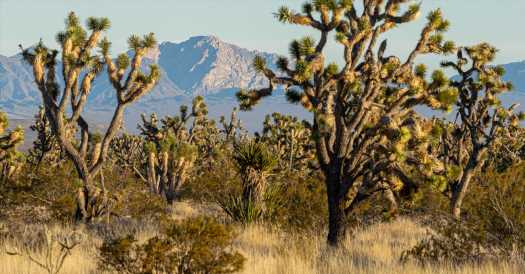Biden Plans to Name Nevada’s Spirit Mountain Area a National Monument

WASHINGTON — President Biden plans next week to designate nearly a half-million acres of the Spirit Mountain area in southern Nevada as a national monument, according to two people familiar with the matter, protecting some of the most biologically diverse and culturally significant lands in the Mojave Desert.
The area, also known by the Mojave name Avi Kwa Ame, represents the largest such monument that Mr. Biden has designated to date. But it could also put some of the most potentially productive land in Nevada off limits to wind and solar projects.
Avi Kwa Ame is considered the creation site for Yuman-speaking tribes like the Fort Mojave, Cocopah, Quechan and Hopi. Their stories place it at the center of the universe.
Native tribes, environmental groups, local and state leaders have been seeking the designation for more than a decade. The administration is using the authority of the 1906 Antiquities Act to protect the area from development.
“I’m committed to protecting this sacred place that’s central to the creation story of so many tribes here today,” Mr. Biden told a gathering of Native leaders at a White House tribal nations summit in Washington late last year.
The Biden Administration’s Environmental Agenda
About 33,000 acres of the Spirit Mountain area were already protected under the 1964 Wilderness Act. The newly expanded monument would create a corridor that links several protected areas, from Mojave National Preserve and Castle Mountains National Monument in California to Sloan Canyon and Lake Mead national recreation areas in Nevada and Arizona.
That would ensure a migratory path for desert bighorn sheep and mule deer, and protect critical habitat for the desert tortoises, bald eagles, peregrine falcons, western screech owls and Gila monsters that are native to the region. Some 28 species of native grasses, a number of them rare, also grow there, as well as some of the oldest and largest Joshua trees in the United States.
The new protection for the land is “incredibly crucial,” said Taylor Patterson, executive director of Native Voters Alliance Nevada. “It’s thrilling to be a part of the culmination of this effort.”
Mr. Biden has also used the Antiquities Act to create a national monument at Camp Hale, Colo., and to restore three monuments that had been shrunk by President Donald J. Trump: Northeast Canyons and Seamounts, Bears Ears and Grand Staircase-Escalante.
To date, the Bears Ears national monument in eastern Utah has been the only national monument to explicitly address its Indigenous roots. (Today, the monument is comanaged by a council made up of delegates from five tribes.) The designation of a second one appears designed by the administration to send a message to Indigenous communities who have long fought for a meaningful say in the management of their ancestral lands.
Deb Haaland, the head of the Interior Department and the nation’s first Native American Cabinet member, said at last year’s White House Tribal summit, “I am thrilled that President Biden is committed to protecting this sacred place.”
The creation of the national monument could spur pushback from renewable energy companies seeking to develop in one of the nation’s best regions for wind and solar power, at a time when Mr. Biden has promised to speed up the country’s transition to clean energy.
Currently there is no wind or solar development within the proposed monument area, according to a spokeswoman for the Interior Department, who noted that much of the land was excluded from energy development under a federal conservation designation.
There is one pending application for a 700-megawatt solar project in one part of the potentially designated land that has been identified as an exception from the conservation designation, according to the Interior spokeswoman.
Outside of the boundaries for the proposed national monument, the federal government has identified 9 million acres of public lands in Nevada for large-scale solar development and nearly 16.8 million acres of public lands for potential wind development.
Source: Read Full Article